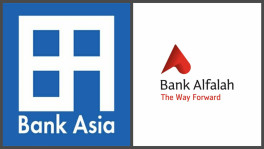Female employment is rising rapidly. Then why are women-only buses ‘unprofitable’?
Women-only bus services run by BRTC and Rangs Motors’s Dolonchapa have both radically scaled back operations, although, as more and more women enter the workplace and educational institutions, demand for safe transportation is rising

A private bank employee, Farhin Tamanna has to travel from Kazipara to Motijheel everyday for work. During peak hours, an Uber car ride can cost as much as Tk550 or Tk600, which she cannot afford regularly.
"Once or twice a month is fine, but if I took Uber cars everyday, I would have to spend my entire salary on these rides", Farhin shared with us. So, she prefers commuting by women-only bus services in the capital.
Farhin remembers in 2014, she saw a BRTC single decker bus at the Kazipara bus stand. A female conductor was calling out to passengers.
"At first I did not understand what was happening, then I saw only women sitting inside the bus and realised it was a women-only bus. Although it was sardine-packed with passengers, I did not mind getting on it as I felt comfortable travelling with them, rather than a bus full of men."
In 2019 Farhin found another bus named Dolonchapa, a bright fuschia coloured 36 seaters women-only bus that also ran along her route - from Mirpur to Motijheel.

"This one I liked more for their comfortable seats and most importantly, they have an app that has an option called location-tracker. I can track where the bus is and get ready accordingly."
But recently, Farhin says, she has to wait longer for the bus to arrive at the bus stand.
"I do not know whether it is traffic or the bus service has actually fallen in terms of quality, but nowadays I do not wait for it and try to get on any of the regular buses," she said.
Women-only bus service was introduced in Dhaka city in 2010. BRTC (Bangladesh Road Transport Corporation) took the first initiative to create a separate bus service for women in the capital.
And then in 2018, Rangs Motors introduced Dolonchapa, a women-only bus service. Both of these services follow the government bus fare chart, starting from Tk10.
The passengers include mostly service holders, students, mothers who commute to their children's schools and women who travel out of necessity. Male passengers are prohibited in these buses. Although the drivers are male, the conductors are female.

But according to service-providers, these bus services have proved to be 'unprofitable' and hence they are struggling to continue it.
BRTC started with 22 buses for the women-only service, which has now come down to four as the remaining 18 have been abandoned in phases over the past few years.
The four buses for women ply on four routes – Joarshahara to Motijheel, Mohammadpur to Motijheel, Mirpur to Motijheel and Narayanganj to Motijheel.
According to officials, instead of being repaired, the buses dedicated to female commuters are now housed at the Motijheel and Kalyanpur bus depots, after they were damaged.
"Six buses remain abandoned here for the last five years and now they are useless. No part of them is usable anymore," BRTC Kalyanpur Depot Manager Noor-e-Alam told The Business Standard.
Similarly with Dolonchapa, they started with four buses, with a plan to increase the number to 60. But in the last four years, they did not increase the number and on top of that, they provide only two trips now, while they provided four earlier. And that too on one route only - Mirpur 12 to Motijheel.

More male passengers than female ones
We reached out to SM Masudul Islam, director of finance and accounting of BRTC.
"If we dedicate a 54 seat single decker bus for women only, most of the time it would remain empty, other than during peak hours. On the other hand, a unisex bus will be fully-packed, with passengers standing on the aisle. So at the end of the day, women-only buses do not bring profit. We cannot bear the operating costs, not even the cost of fuel with the fare it charges."
Sohana Rouf Chowdhury, the managing director at Rangs Motors Limited and Dolonchapa agree. She said, "The challenge with catering to a women-only bus service is that other than the peak hours, we do not get many passengers. Half of the passengers are mostly students who pay the half-fare. Only 25% of our passengers are working women who we can refer to as regular passengers."
"When we monitored closely, we found there are several specific times when most women commute - either during office hours or school hours and on holidays in the afternoon. Other than that, women mostly do not prefer to get out on the roads," said Faria Rasul, project in charge of Dolonchapa.
But Sohana Rouf still feels hopeful with her initiative.
She said, "More and more women are getting education, which will eventually increase women-employment. I am sure this women-bus service will work. I do not want to lose hope. For now, we may opt for ride sharing solutions like Shuttle. Let us see what happens."

Shuttle is a women-oriented app based ride sharing service that provides microbus and minibusses. They have women-only as well as unisex transportation services. For everyday use, a user can book a seat for Tk130 for any route in Dhaka, while the monthly package costs Tk5,000.
We talked to Sayem Chowdhury, vice president of Shuttle. He informed us their women-only transportation service is only for female university students. For this, they need eight to 10 six-seater microbuses.
"But our unisex services are generally for office-goers and if we look into the demography, only 20% of them are women. Our experience says that running a women-only transportation service would be tough as not many women tend to travel throughout the day," Sayem said.
He continued, "For any post advertised, we get more male applicants than female - this reflects the current employment demography, sadly. And if you consider female workers, apart from some professions, many hold desk jobs or jobs that do not require a lot of travelling. This is one big reason behind women-only bus services coming out as unprofitable."

Women more comfortable when travelling with women
According to a Brac study titled 'Sexual harassment and accident-free roads for women', 94% of women in the country face sexual harassment while travelling by public transport. Both bus staff and aberrant passengers commit such crimes.
According to another survey by ActionAid, 42% of female passengers are sexually harassed by male passengers and 53% by transport operators in big cities.
From 2008 to 2017, female employment in Bangladesh increased by 35%, reaching 18.1 million, while male employment saw an 11% increase during the same time period, according to 'World Employment and Social Outlook: Trends 2018', a report prepared by International Labour Organisation (ILO).
According to Bangladesh Bureau of Statistics (BBS), the number of economically active women in Bangladesh is increasing rapidly. Their statistics showed the total number of economically active population was 61.4 million in 2015, where 18.3 million were women.
Of them, a large number of women are working in the capital. But compared to high-income working women, the low-income women face more trouble in terms of transportation and they have to depend mostly on the public transport system.

According to a recent study titled 'Gap analysis between women passengers' perception and expectations about bus service: A case study on Bangladesh', in recent years, the number of female commuters has increased rapidly for education, job, business etc.
A substantial part of our population, 49.4%, is women. According to the 2018 Unesco report, the female literacy rate of Bangladesh stood at 71.18%.
The number of women working has increased from 54 million in 2010 to 61 million in 2017.
Bangladesh is the world's second-largest exporter of Ready-made Garments (RMG) after China. The RMG sector employs approximately 4.2 million people, with women accounting for 80% of the workforce, with a significant number of garment and textile industries located in Gazipur and Narayanganj. But unfortunately, there are no women-friendly bus services on these routes.
President of Bangladesh Mahila Parishad Fauzia Moslem demanded an allocation of 100 buses for women from among the 400 BRTC buses running in the capital.
"There is no chance of any financial losses on these buses. The losses are incurred due to corruption," she told TBS.


 Keep updated, follow The Business Standard's Google news channel
Keep updated, follow The Business Standard's Google news channel
















